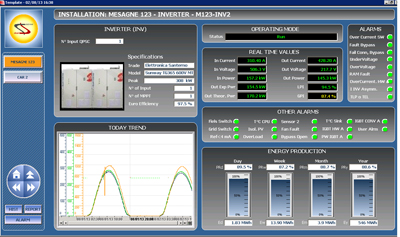Optimizing Solar PV Energy Generation & Plant Performance: The SCADA solution
 To maintain an efficient solar electric photovoltaic (PV) system, a performance monitoring system is a must for long-term accountability. Assessing in real-time the amount of energy produced and ensuring the conversion efficiency remains high and intact over time, is important to the success of the system. System monitoring also makes sure that immediate action can be taken to resolve any problems or adverse events. There’s little purpose in installing solar power if it isn’t going to maximize energy production.
To maintain an efficient solar electric photovoltaic (PV) system, a performance monitoring system is a must for long-term accountability. Assessing in real-time the amount of energy produced and ensuring the conversion efficiency remains high and intact over time, is important to the success of the system. System monitoring also makes sure that immediate action can be taken to resolve any problems or adverse events. There’s little purpose in installing solar power if it isn’t going to maximize energy production.
Tracking consumption
Chances are you’re familiar with the residential electric meter used by most utility companies to record and bill the monthly kilowatt-hours of energy consumed. Over the course of a year, these bills can be compared to assess and determine one’s monthly consumption. Although this scenario illustrates usage consumption, it’s different for monitoring production with PV systems.
PV systems use semiconductor cells to convert, with determined efficiency, sunlight into direct-current (DC) electricity. Usually made of silicon, cells come wired together in a panel or a group of panels, which are mounted together on a frame, called a PV array. PV systems also include several pieces of equipment, in addition to the PV array. The balance-of-system (BoS) components, for example, include: the racking and mounting equipment for the solar panels; the combiners, inverters, and wiring; as well as the transformers and a form of electricity storage if so desired (which are, typically, batteries).
A meter is also used to measure the energy produced in PV systems. But, instead of a monthly consumption rate, the amount of energy produced during short time intervals is more important when it comes to solar energy. Dataloggers are often used to help monitor residential solar systems, as they feed data into a memory system that can be archived for use later on. Communication interfaces, such as Ethernet or serial ports, are also used to allow a computer to connect and retrieve this data as required. Monitoring can be done from every five minutes to every hour or so. The greater the recording frequency (such as for larger, community-scale or even utility-scale systems), the more accurate the metering.
Interconnection
Most electric utilities in the United States have adopted standard criteria and guidelines for interconnection of distributed generation (DG) to their electric distribution systems. Household PV system effectively reduce customers energy demand from the grid and, during minimum loading conditions, allow consumer export energy back to the utility. The balance of demand and export transactions are often referred to as “net energy metering” (NEM).
A set of guidelines (IEEE P1547.6) have been recommended by the Institute of Electrical and Electronic Engineers (IEEE) to PV system integrators, so as to support them in properly designing systems operable in parallel with those of the utility systems.
Back in 2009, one of the first PV automated management systems was designed to meet these guidelines. The initial design at the time comprised of a simple data acquisition system (DAS), but this was quickly revised. It became apparent that due to the volatility of solar radiation at ground level (mainly due to atmospheric turbulence), a fast sampling pace of about five seconds or less would be required.
The case for SCADA
Because of tighter timing requirements, it was determined the best approach to develop a performing PV management applications would be to use an industrial-established Supervisory Control and Data Acquisition (SCADA) environment. This would allow designers to manage data streams in the range of several thousand measures per second without complications. After conducting numerous system tests as a proof of concept, a low-weight, industrial SCADA software was adopted to meet the overall PV application requirements.
This SCADA provided flexibility in monitoring and controlling various plant components and operations, including trackers, inverters, substations, and meters. Designed for the monitoring of performance, the system logs any problems and triggers an immediate alarm so that engineers can fix or change any components, or fine-tune the process of plant operation. Efficiency in energy production and plant operations are keys.
Though monitoring systems are now commonplace in PV systems, those SCADA based systems monitor PV performance by means of sophisticated mathematical model that are initialized during project installation according plant design data: PV panels peak power; inverters; manufacturer-provided electric parameters; number of panels and strings; string length; and more. Continuously fed with local weather data, the monitoring system can calculate in real-time what would be the correct energy production at 100% of plant capacity.
The automatic comparison between the calculated and the real production figures (supplied by a datalogger) provides a precise indication of plant performance and plant health every minute or less.
Data acquisition
From a technical standpoint, it’s worth noting how overall data acquisition is performed. From the DC level, string combiner boxes designed for PV installations have built-in electrical probe units, which measure the values of DC current, voltage, and PV panel temperature. Through a serial RS485 port (different methods, including wireless, can be used)—those data are transferred to the SCADA usually via ModBus protocol. Some remote terminal units (RTUs) are installed at the project site, and connected to multiple string junction boxes on the RS485 multi-drop loops.
At the AC level, inverters expose also RS485 ports to allow for easy connection. The native communication drivers collect data from control boxes and RTUs, labeling those with a time stamp for real-time processing, storage, alarming, reporting, and displaying. This occurs for the DC-side and AC-side parameters, so the system status and diagnostics can be acquired continuously.
SCADA capabilities are further used in monitoring of grid protection relays, energy meters, weather monitoring station/sensors, control panels, DC switches, transformers and, in general, any devices capable of affecting solar plant production. Additionally, to make PV applications as efficient, maintainable, and scalable as possible, it’s important to take into consideration other aspects of the SCADA application. These include dynamic configuration, stand-alone and client-server configurations, redundancy for data protection, historical and real-time trends analysis, as well as advanced alarm management.
Looking further at compliance, the support of such protocols as IEC 61850 and DNP3 are considered an asset if it’s ever necessary to communicate with various electric sub-station devices.
Today, monitoring and performance analysis of solar PV plants has become critical due to increasing operation and maintenance (O&M) costs. Monitoring is also important for reducing yield due to performance degradation during the lifecycle of a solar PV plant and the lifetime of the plant’s equipment. The use of a monitoring system is essential to ensure high performance, low downtime, and fault detection of a solar PV system.
Staer Sistemi
www.staersistemi.it/en
PcVue
www.pcvuesolutions.com
Author: Emmanuel Ecochard & Lino Picheo
Volume: November/December 2013









.png?r=3625)

